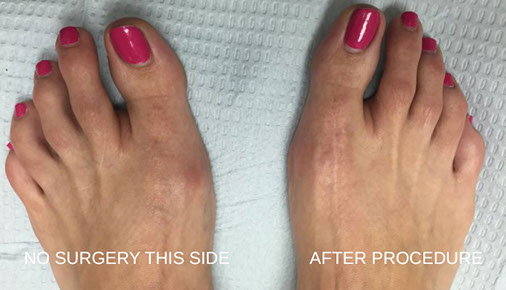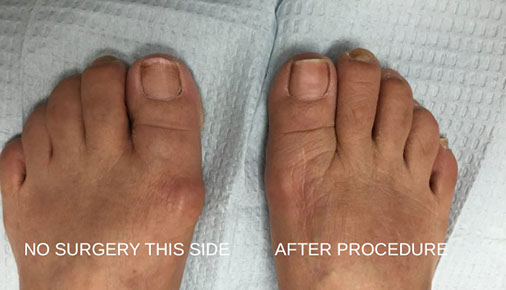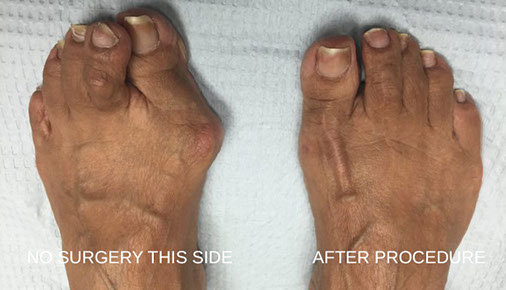Bunion Surgery
Pain Relief, Cosmetic Outcome

WHAT IS A BUNION, HOW IS IT CAUSED? A bunion is an enlarged or prominent bone on the side of the first, big toe joint. This condition is often inherited and worsens as the joint responds to abnormal pressure on the foot from tight, restrictive or flat shoes without support. Pressure on the big toe joint causes the big toe to lean toward the second toe. Over time, the normal structure of the bone changes, resulting in the bunion bump. This deformity will gradually increase and may make it painful to wear shoes or walk.
Pain ranges from dull to sharp depending upon the level of irritation and compression of the nerves that are around this area.
CAUSES
The bump is a sign that the bones of the foot are out of alignment. While shoes with high heels or pointed toes may cause the joint to ache, they don't cause bunions. Most often they are due to an inherited foot structure. The tendons and ligaments that hold bones and muscles together at the joint are not working as they should. This structure makes it more likely that a person will develop a bunion.

LET'S TALK
Book a consult
PRIVATE ONLINE CONSULTATION WITH A SPECIALIST DOCTOR
Book a consult
PRIVATE CONSULTATION WITH A SPECIALIST DOCTOR
PROCEDURES
Cosmetic, Corrective and Reconstructive Specialists

CASE TESTIMONIAL
A complete cosmetic foot surgery makeover in essence is specific to each patient. In this case, the bunion, bunionette, hammertoes, and skin / corn deformities that she had from birth were corrected on her right foot first.
Bunion Progression
Bunions start out small — but they usually get worse over time (especially if the individual continues to wear tight, narrow shoes). Because the metatarsophalangeal joint (MTP) joint flexes with every step, the bigger the bunion gets, the more painful and difficult walking can become.
An advanced bunion can greatly alter the appearance of the foot. In severe bunions, the big toe may angle all the way under or over the second toe. Pressure from the big toe may force the second toe out of alignment, causing it to come in contact with the third toe. Calluses may develop where the toes rub against each other, causing additional discomfort and difficulty walking.
Symptoms of a Bunion
In addition to the visible bump on the inside of the foot, symptoms of a bunion may include:
- Pain and tenderness
- Redness and inflammation
- Hardened skin on the bottom of the foot
- A callus or corn on the bump
- Stiffness and restricted motion in the big toe, which may lead to difficulty in walking
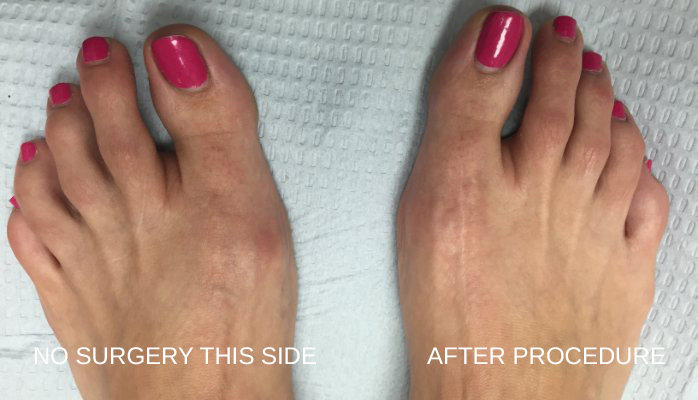
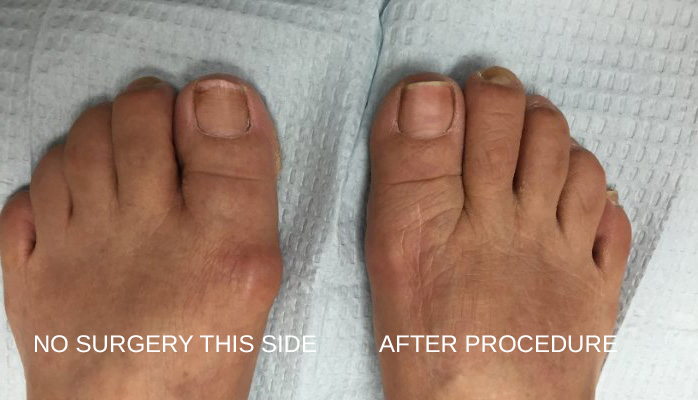
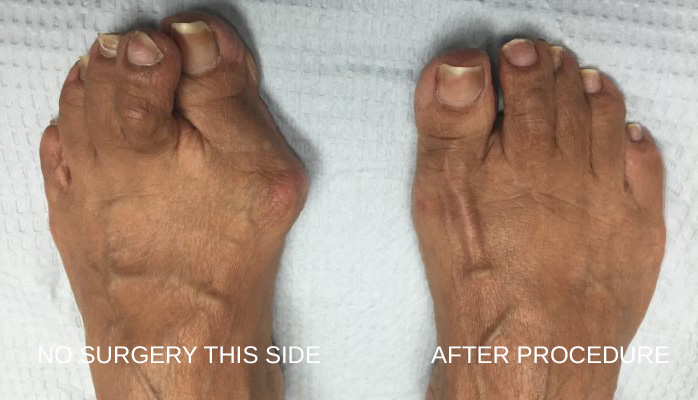
This patient had a mild bunion where only the 'bump' or prominent portion of the first metatarsal head was hurting in her high heels. Although you could consider this a cosmetic foot surgery, we consider all of our bunion (or hallux valgus) surgeries both for structural (straightening the joint and reducing the size) and cosmetic (sculpting the inside portion and keeping a natural curvature to fit in shoes) outcomes.
Additionally the foot surgery techniques and equipment continue to advance to where these patients have less post-operative pain and are able to go back into shoes as early as 4 weeks. We used a non metallic pin (biologic bone material - TenFUSE) to fix the osteotomy (or surgical fracture) and stabilize the correction after it was shifted to a more normal position.
Surgical Correction of Bunion
The procedure is performed in a local out-patient surgical facility. The recovery is shorter than in the past, and health insurance usually covers this type of surgery.
In general, the common goals of most bunion surgeries include:
- Realigning the metatarsophalangeal (MTP) joint at the base of the big toe
- Relieving pain
- Correcting the deformity of the bones making up the toe and foot
Because bunions vary in shape and size, there are different surgical procedures performed to correct them. In most cases, bunion surgery includes correcting the alignment of the bone and repairing the soft tissues around the big toe.
Your doctor will talk with you about the type of surgery that will best correct your bunion.
Specialized Technology:
Tayton uses the latest technologies. The bone needs to be moved, and in order to secure it in a new position, many surgeons would use metal plates and screws. By contrast our procedure calls for natural cortical bone pins, that are completely absorbed by the body, and will never need to be removed.
Also, our surgeons will complete the procedure with a difficult closure where the sutures are underneath the skin - subcutaneous stitches will minimize scarring.
Book a Consultation
PRIVATE ONLINE CONSULTATION WITH A SPECIALIST DOCTOR
YOU CAN ALSO CALL US:
1 800 TAYTON 1
Frequently Asked Questions
About Tayton
Sports Injuries / Trauma
Anesthetic / Sedation
Insurance and
Finances
Cosmetic Surgery
The Tayton Institute is a group of medical specialists who have joined together to build a practice focused on surgical excellence.
It is difficult for the premier independent doctors to be recognized these days. Anyone can buy a position in your search results, and much is also true of the many of the ratings sites. Tayton has exceptionally high standards for education, residencies, performance statistics and simply being nice.
We work together to define new technological advances and to pool our resources with the goal of ensuring the best possible outcome for each patient.
Many of our doctors are former athletes and active in a range of sports. We can help you to get back in shape and playing your best.
Book a Consultation

What are the safest options for pain relief ?
As podiatrists and foot surgeons, we are committed to helping patients understand the surgery process. The type of anesthesia that we use for extremity foot surgery is very light. Patients are out and not conscious, which is what most people want to know. You are not going to wake up during the procedure.
Anesthetic is very light and very safe. The procedures are always around an hour to two hours max so there’s not as much time under sedation and henceforth, less complications and less difficulties waking up and feeling groggy or hungover.
More about Recovery
Costs, Insurance and Financial Concerns
Our office will work with you on costs. When patients come into the office, insurance coverage is discussed and verified. We check to see where their deductible is, what type of out of pocket expenses are required so you know where you are on that level.
Second of all, we look into the type of facility. For example, we have in-network and out of network facilities. I am an In-Network foot doctor and foot surgeon in Houston provider so they don’t have to worry about my coverage on their insurance.
Our office submits each procedure so you know about coverage.
We use surgical and non-surgical techniques to improve the appearance of our patient’s feet
Our physicians are the top practitioners in cosmetic foot surgery. We can correct deformities, improve comfort and appearance of feet and ankles.
Talk with a Specialist
Cosmetic and Reconstructive Procedures Healing Pain and Correcting Deformities


Cosmetic
Reconstructive
Dermatalogical
Sports
